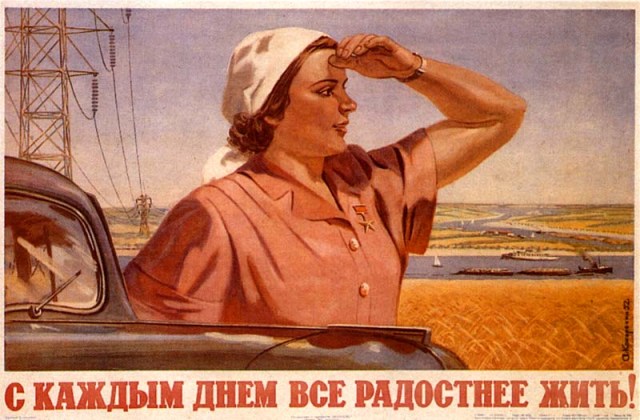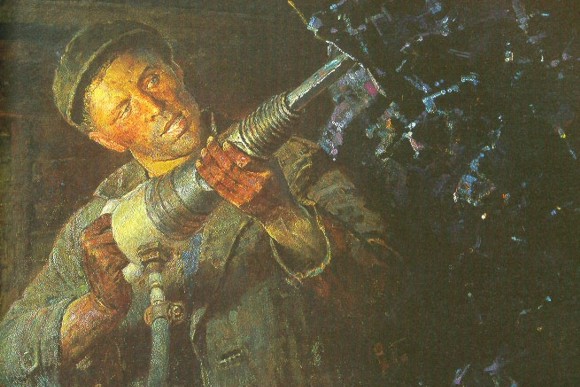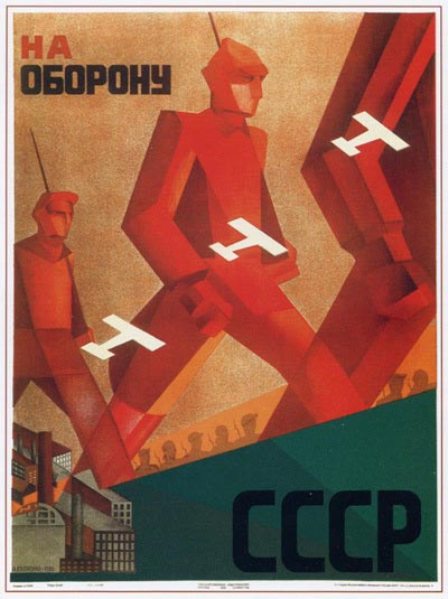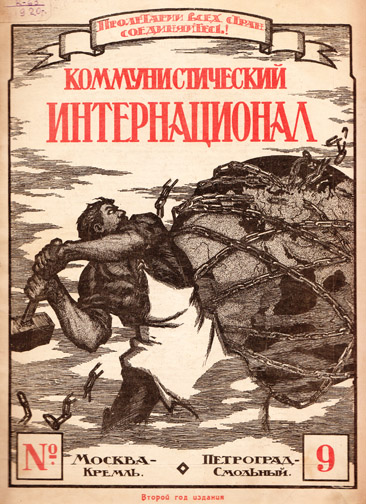The Propaganda Themes
The New Society
A common theme in the Soviet propaganda was to build a new Utopian society. Among other symbols, the use of the word товарищ [tovarishch] or comrade had to keep alive the striving towards a new community. This new society was to be classless. The distinction should be based on function, not on class, and in the newspapers was highlighted how «the dreams of the working class would make the Russians the happiest people in the world».
For this purpose, quite often military metaphors were used. In 1929, for example, the collectivization of agriculture was officially designated as a «socialist offensive on all fronts». An even when, during the second Five-Year Plan, the socialist offensive appeared to slow down, it was explained by the propaganda fanfare as a Soviet triumph «on the battlefield of the building of socialism».
In the Stalinist period, the new society was often portrayed as one big family, with Stalin as the great father. One of the slogans was С каждым днем все радостнее жить [S kazhdym dnyem vsye radostee zhit] or Every New Day Everyone Lives Happier. Being happy was a duty in the communist society which, as the highest and most progressive form of society, was ethically superior to all others.

Every New Day Everyone Lives Happier
The New Soviet Man
A new society included the need for a new man. In ideological terms, the новый советский человек [novy sovyetsky chelovek[ or the New Soviet Man was a person who was prepared to devotedly participate to the building of communism in his country. He was not driven by crude impulses of nature, but by self-consciousness. This selfless New Man was not only willing to sacrifice his life, but also his self-respect and sensitivity. Mikhail Bulgakov's story Heart of a Dog is a satire on the concept of this New Soviet Man.
The term New Soviet Man was originally only used in the male sense. But later the New Soviet Woman was created in the propaganda. Her role was very different from her male counterpart. She was charged with a complex identity that changed depending on the ideology shifts in party doctrine, which evolved toward more conservative views about the role of the family and the role of the mother in the Soviet system. The New Soviet Woman was a superwoman who balanced her responsibilities in fulfilling various roles - a citizeness communist, a full-time employee, a wife and a mother. Mother-heroines received medals when they got ten or more children.
Heroes and role models
The Soviet Union was in need for examples to prove that the new Utopian society was achievable, and that the New Soviet Man existed. When such examples were not immediately available, they were created.
That's why, for example, the party faithful biologist and agronomist Trofim Denisovich Lysenko (1898-1976), a pseudo-scientist, was glorified at the expense of real scientific work. Lysenko made up a genetic theory that supposedly could result in a dramatic improvement of the food production in the Soviet Union, which in those days was under pressure due to problems caused by the forced collectivization of agriculture. The Soviet leaders were very much into Lysenko and his ideas. The propaganda machine glorified him, and Lysenko's humble origins were emphasized. The way in which deviations from Lysenko's official teaching were depicted as «pseudo-bourgeois» and continuously suppressed, has harmed the study of genetics in the Soviet Union badly. His ideas had the support of the Central Committee of the Communist Party and the other scientists were not allowed to deviate from this doctrine. Critics of Lysenko kept their mouths, geneticists got fired or arrested. Nikolay Ivanovich Vavilov (1887-1943), who is now valued because he had useful ideas about the breeding of plants, and who criticized Lysenko in his time, was arrested in 1940 and died in 1943 in custody from malnutrition.

Vavilov, Lysenko and Stalin
Only in 1965, Lysenko was removed from his post as director of the Institute of Genetics at the Academy of Sciences. After Khrushchev's dismissal in 1964, the president of the Academy of Sciences declared that Lysenko's immunity to criticism had officially ended. His secretive methods and ideas were revealed. A few months later, a devastating critique of Lysenko was made public and Lysenko was immediately disgraced in the Soviet Union.
Another example is the miner Aleksey Gregorevich Stakhanov (1906-1970). He was portrayed as a communist hero because, in 1935, in the mines of the Donets Basin, he had axcavated fourteen times the state-required amount of coal. He was a symbol of communist work ethics because he demonstrated the superiority of the socialist economic system. Later was revealed that he was helped by a group of employees. A group which was much larger than average, by the way.
The term Stakhanovist or Stakhanov-worker was regularly used to qualify the ideal Soviet worker: hard-working and quiet. Many Stakhanovists were rewarded with medals, better nutrition and better housing.

Aleksey Gregorevich Stakhanov
Class enemies
Since not everyone turned the duty to be happy into reality, the «class enemies» were a recurring theme in the communist propaganda. When Lenin declared that the bourgeoisie as a class had to be exterminated, the propaganda was directed against the landowners, the wealthy farmers, the banks, factories and shops. In the Stalin era, all opposition leaders were invariably described as «traitors» and «agents of foreign imperialist powers».

In defense of the USSR (1930)
Kulaks and other class enemies were often indicated as the reason for the failure of the collective farms, and during the first and second Five-Year Plans, the kulaks, saboteurs and nationalists were attacked in the run up to the Great Terror. Those who benefited from public property were enemies of the people. During the Голодомор [Holodomor] or the Great Famine in Ukraine in 1932-1933, the victims were even depicted by the propaganda as the perpetrators. The starving peasants were denounced as saboteurs, who were even more dangerous because their soft appearances made them seem harmless. The dead bodies proved that the farmers hated socialism so badly that they were willing to risk their lives and their families to fight it.
The class enemies were arrested and lodged in the prison camps of the Gulag, which were dubbed by the propaganda as corrective labor camps. And it worked, because many of those who had seen the hunger and the slavery believed the propaganda rather than their own eyes.

Destroy the kulaks as a class (1930)
Production
Stalin had declared that the Bolsheviks had to catch up a backlog of fifty or one hundred years to Western countries in ten years, otherwise socialism would be destroyed. Newspapers continuously published messages saying that the production quotas had been exceeded, which usually wasn't true. And where it was, the goods often seemed to be sloppily put together.
During the '30s the development of the industrial production of the Soviet Union was an important theme in art, literature and film. Although a majority of the population still lived in the countryside, the Soviet Union had to be proclaimed as a mighty industrial power.
In 1939, a reduction of the production quotas had been suggested, but that plan was not accepted because it could harm the propaganda, which had reflected an improvement in the sort of the people, for whom life was getting happier and better every year.
Peacefulness
An important theme in the propaganda to the outside world was the image of the Soviet Union as a peace-loving nation.
Reality was different from what the propaganda wanted to show, though. The Molotov-Ribbentrop Pact which was concluded between the Soviet Union and Nazi Germany in 1939, was at first sight a non-aggression pact between the two countries. But in 1946, during the Nuremberg Trials, it was revealed that a number of secret protocols had been agreed on the boundaries of the influence spheres of the two countries. Poland was divided between the two signatories, the Baltic states Finland, Estonia and Latvia were agreed to come under Soviet influence, as well as some parts of Romania. With this, the Soviet Union restored significantly the limits of the Tsarist Russia in the 19th century.
One week week after the signing, Germany invaded Poland and started World War II. On September 17, 1939, the Soviet Union invaded Poland from the east to take its part of the protocol. The Russian army met the German, and they celebrated their partnership with a big parade in Brest-Litovsk, which had become a Russian city again. On the orders by Stalin, thousands of Polish officers and intellectuals were murdered in Katyn, in order to break the resistance against the Russian domination. Hundreds of thousands of Poles were exiled to Siberia for a long time. The next step was the occupation by the Soviet Union of Estonia, Latvia and Lithuania. Later followed by parts of Finland and Romania.
But when Stalin demanded more influence in the Balkans and a military base on the Bosphorus, by which the Soviet Union could extend its influence to Turkey, Germany invaded the Soviet Union on June 22, 1941, and the pact could be regarded as abolished.
The Soviet Union has continued for years to deny that the pact has ever had a secret protocol. The text of the secret protocols was first published in the Soviet Union in August 1988 by Estonian newspapers Rahva Hääl. Only on December 24, 1989, the Soviet Union officially admitted the existence of secret protocols.
Internationalism
Even before the Bolsheviks seized power, Lenin had said that the Russian revolution was the «vanguard of a global revolution», and that it would be socialist and international. The propaganda made sure that the workers were well aware that they were the vanguard of world socialism, the slogan «Workers of the world, unite!» was constantly repeated.
At the insistence of Lenin, the Third International was founded in 1919. It got also known as Коммунистический интернационал (Коминтерн) or the Comintern. It was meant to be a global alliance of communist parties led by the Communist Party of the Soviet Union. Stalin used it to promote communism throughout the world for the benefit of the Soviet Union. Because this idea was rather disturbing for the Allies in World War II, the Comintern was disbanded in May 1943, and later, in March 1944, The Internationale was replaced as the Soviet anthem by the Hymn of the Soviet Union.

Comintern magazine from 1920
Personality cult
Lenin felt uncomfortable with the personality cult which was shown to him, yet this cult was used during the civil war, and after his death it was even officially stressed. In 1918, the biography of Lenin was published and busts of him were produced. After his death, his embalmed body was displayed and books and photographs were produced in large quantities.
Stalin presented himself as a simple man of the people who stood out from everyday politics by his unique leadership role. His clothes were carefully selected to support this image. The propaganda made him first an heir of Lenin but, as time passed, he became Lenin's match, and later outflanked him all the way. From the late '20s, Stalin was portrayed as the principal military leader of the civil war, but that role was exposed as insignificant in the '60s. There were very precise regulations about how the life of Stalin had to be presented, and how he had to be depicted. Less appropriate facts, such as the fact that he had been prepared to work with the tsarist government on his return from exile, were removed from his biography. In the Soviet propaganda, everything was made possible thanks to Comrade Stalin. Technical projects were said to be proclaimed by Stalin personally. Young Pionieers had to fight for the cause of Lenin and Stalin. The padded propaganda was so powerful that many young people idolized Stalin. During World War II he made a fleeting visit to the front so that propaganda could claim that he had risked his life for the soldiers in the frontline. The cult was somewhat mitigated when the victory was near.
As Stalin got more power, the propaganda was also used to bring down his opponents. For Trotsky, for example, a complete anti-personality cult was constructed.

Study the great track of Lenin and Stalin
Eradication of vermin
An important purpose of the communist propaganda was to justify the political repression against - and even the eradication of - social groups hostile to Marxism and the proletariat. An important goal of the communist propaganda was to create exciting and violent political emotions against the enemies of the regime, so that they could be eliminated without resistance from the people.
A characteristic feature in this kind of propaganda was the denial of the human nature of such groups. Vladimir Lenin called for the destruction of the enemies, like vermin, lice and leeches.
In 1933, Maksim Gorky (1860-1936) published his work Канал имени Сталина [Kanal imeni Stalina] or The Stalin Canal. He wrote that a class hatred had to be fostered by an organic aversion to the enemy. Enemies had to be seen as inferior. He even suggested to use enemies of the people as human guinea pigs for experiments in the Soviet Institute of Experimental Medicine, and presented this idea as «a genuine service to humanity».
In The Master and Margarita, Mikhail Bulgakov repeatedly referred to this phenomenon, especially in the reproaches which Bezdomny screamed out in doctor Stravinsky's hospital.